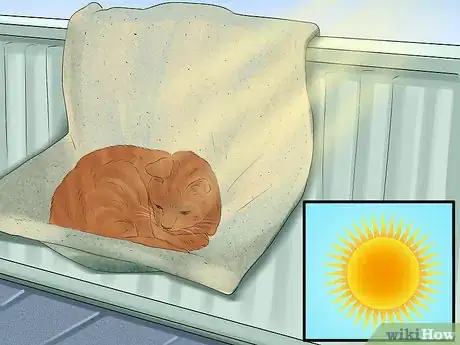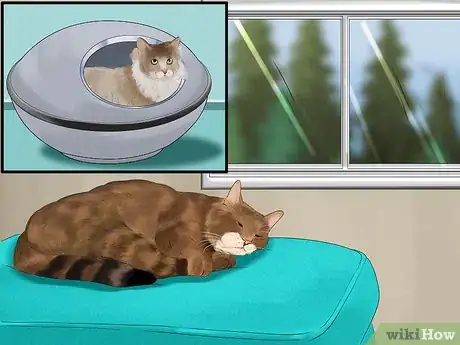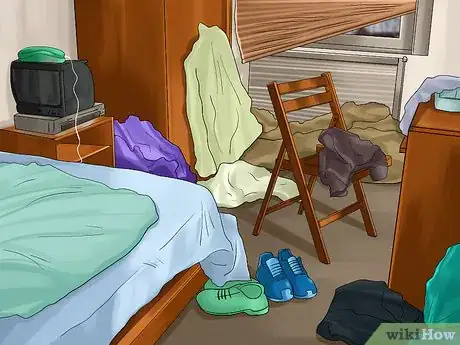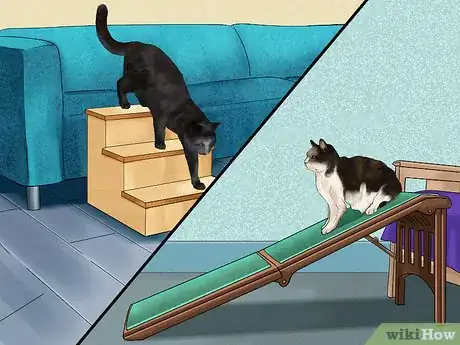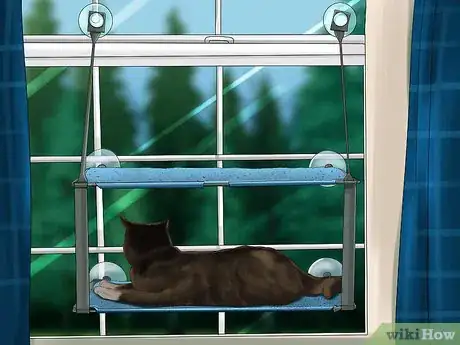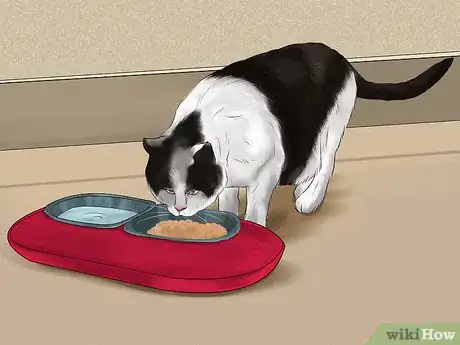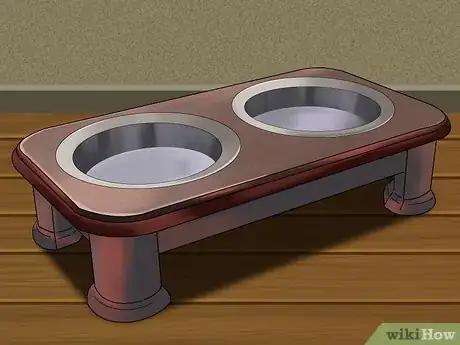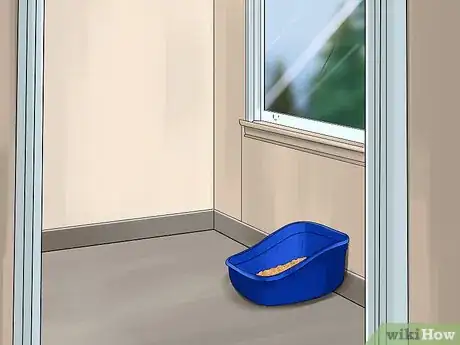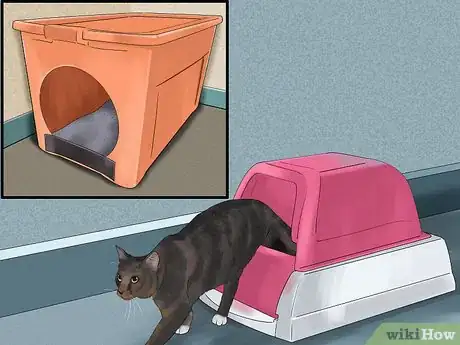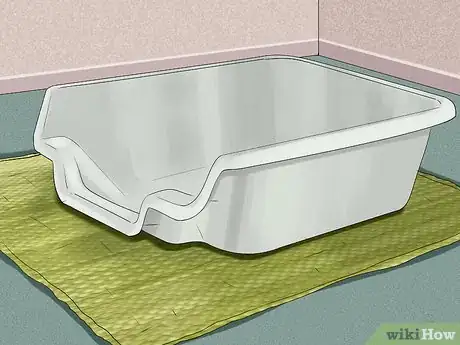This article was co-authored by Lauren Baker, DVM, PhD. Dr. Lauren Baker is a Veterinarian and Assistant Scientist at the University of Wisconsin-Madison. With over 10 years in veterinary medicine, she specializes in the concept of “one health,” which uses insights from veterinary medicine to help human medical research. She holds a Ph.D. in Comparative Biomedical Sciences, a Doctor of Veterinary Medicine, an MS in Comparative Biomedical Sciences, and a Bachelor’s degree in Psychology from the University of Wisconsin-Madison.
This article has been viewed 12,426 times.
As your cat gets older, you will need to make adjustments to your home to help make it comfortable and accessible for the cat. These adjustments will likely include changes to the location of its food, litter, and water. They may also include giving the cat new ways of accessing its favorite spots or new spots that it now finds appealing. Overall, if you take the time to assess your senior cat's basic needs and then figure out how you can make it easier for the cat to get those needs met, you will have a much happier and healthy senior cat as it ages.
Steps
Making Your Space Cat Friendly
-
1Provide a warm, cozy place to sleep. As your cat ages, it may be more inclined to spend its time napping in a warm spot. Place your cat's bed in a location that gets lots of warm sun or is near a heating vent. In a great spot, your cat can spend it days cozy and contented.
- If you want to make your cat extra cozy and warm, consider getting it a heated cat bed, which plugs in and provides gentle warming.
-
2Give access to quiet spaces. If you have a multi-cat household or a home that is generally loud and active, you may need to provide an older cat with a space to escape the noise. Give your cat access to a quiet bedroom or a warm, sunny corner away from the noise.
- Make sure to let all family members know that the cat should be left alone when it goes to its quiet area.
- Keep other pets out of this quiet area so that the senior cat can get some rest and relaxation.
Advertisement -
3Remove dangers in the cat's space. If your cat is losing its sight or is generally losing its function, you may need to adjust what objects are in its space. For example, if your cat has gone blind, you need to remove clutter that is in the cat's usual paths so that it doesn't bump into things. You don't want a cat that is blind having to navigate around random objects you leave lying around.[1]
- Keep your furniture in the same locations, if possible. This will allow a cat who is losing sight to find its way around your home based on memory.
- If you cannot remove all dangers, you may need to find a way to keep older cats out of dangerous areas. This can often be done with baby gates, as older cats are less likely to expend the energy to jump over them.
-
4Provide ramps and steps for accessibility. If your cat has mobility problems, anywhere from minor arthritis to an inability to move around without a wheelchair or cart, it may benefit from some accessibility ramps or steps. This could include adding steps up to your bed, so that your cat can sleep where it has always slept. It could also include adding ramps in your home so that a cat in a cart can move around its home.[2]
- Not all accessibility solutions mean adding stairs and ramps to your home. You can simply rearrange furniture to make it easier for your cat to get to a high spot. Putting a bench at the end of your bed, for instance, may make it so your cat can jump up onto that and then up further onto your bed.
-
5Give access to views of the outdoors. As your cat ages it will be less able to be physically active but it will still need to have its mind stimulated. With this in mind, give it easy access to a place where it can watch the world outside. Giving a senior cat a spot where it can view the goings on in the neighborhood will be give it a fun activity that is stimulating to its mind.[3]
- Giving your cat a spot where it can watch the world may require that you install cat perches or some other way for the cat to get up to a window. It could simply mean that you put a piece of furniture next to a window so that the cat can sit on it and look outside.
- This is especially important for cats that can't or don't want to go outside. It is common for very old cats to avoid going outside as much as they might have previously.
Adjusting Feeding
-
1Provide easy access to food. As your cat ages it will be less able to climb up to food dishes on high points, such as kitchen counters. If you have traditionally fed your cat on a high surface, move its food down to the floor. Giving your cat easy access to its food will help assure that it eats enough food to stay healthy and happy.
- This is especially important for cats that have mobility issues, such as cats with arthritis or other age-related movement problems.
-
2Put food in elevated cat dishes. While you shouldn't put your cat's food dishes on a high counter, it is a good idea to raise them off the floor. Putting your cat's food in an elevated dish, which lifts the food a few inches off the floor, will make it easier for your cat to eat its food.[4]
- Elevated cat dishes allow your cat to be in a more neutral position when eating than bowls on the floor do. Basically, they make it so your cat doesn't have to bend over.
-
3Give unlimited access to water. As your cat ages, it is more likely to suffer from dehydration. Because of this, be sure to provide unlimited access to water. Also consider providing water dishes in multiple locations in your home, so that your senior cat can easily have a drink of water whenever it wants one.
- Transitioning your cat from a dry kibble diet to a wet, canned food diet can also help your cat get more water.
- Consider providing a cat drinking fountain for a cat that is hesitant to drink water. These fountains recycle water in a stream, which can lure cats that are interested in running water into drinking.
-
4Give your cat a calm place to eat. Some older cats have a hard time getting enough to eat if they are forced to eat in an area that is loud, noisy, or filled with other pets. Consider giving your older cat a quiet place to eat where it can be all alone and focus on its meal.
- This could be as simple as letting the older cat eat in the kitchen alone before you let other pets in to eat.
- You could also give your senior cat its own special space, such as a landing or kitchen pantry floor, where only it is allowed.
Changing your Cat's Litter Box
-
1Put the litter box in an easily accessible location. It is important to give your cat easy access to its litter box so that it is able to get to it without a lot of effort or discomfort. Placing the litter box in an area close to where the cat spends most of its time is important. Also, a cat with mobility issues should not have to climb up and down stairs to get to its litter box. This means that litter boxes in basements or other out of the way places may need to be placed somewhere closer to the cat's area.[5]
- Putting a litter box in a central location in your home can be a drag but it is better to have a litter box there than to have accidents in the house.
- Having a litter box in a central location in your home will also make you more likely to clean it regularly, as you will see it often and you will have to deal with the smell and sight of a dirty litter box.
-
2Consider putting multiple litter boxes in your home. As a cat ages it will have less ability to wait to go to the bathroom when it has the urge. If you provide it with multiple litter boxes, your senior cat is more likely to make it to one and to not have an accident in the house.[6]
- Providing multiple litter boxes is most important in homes that are large in size. If your cat never has to go far to get to its litter box, for instance if you live in a small apartment, multiple boxes is not necessary.
-
3Use a litter box with low sides. As your cat loses mobility, it will be harder of it to get in and out of a litter box. Consider providing a litter box with low sides or a low entrance area. This will help assure that it uses the litter box when it needs to and that it doesn't choose somewhere else in the house to go to the bathroom.[7]
- A litter box with low sides can be messier than a litter box with high sides. Try putting the litter box with low sides on a large mat that will hold stray litter in place and that can be easily shaken out or vacuumed regularly.
- If you can't find a litter box with low sides, try making your own using a plastic storage container. Cut out a low opening in one side of the container with a utility knife, then fill with litter and you are ready to go![8]
References
- ↑ http://www.petmd.com/cat/centers/nutrition/slideshows/how-to-care-for-senior-pets?utm_source=slide%20show&utm_medium=footer&utm_campaign=how-to-care-for-senior-pets
- ↑ http://www.petmd.com/cat/centers/nutrition/slideshows/how-to-care-for-senior-pets?utm_source=slide%20show&utm_medium=footer&utm_campaign=how-to-care-for-senior-pets
- ↑ http://www.companionanimalpsychology.com/2012/05/cat-at-window.html
- ↑ http://www.vetstreet.com/our-pet-experts/catification-for-senior-pets
- ↑ https://www.aspca.org/pet-care/cat-care/common-cat-behavior-issues/litter-box-problems
- ↑ https://www.aspca.org/pet-care/cat-care/common-cat-behavior-issues/litter-box-problems
- ↑ http://www.vetstreet.com/our-pet-experts/catification-for-senior-pets
- ↑ http://petprojectblog.com/archives/cats/make-your-own-cat-litter-box/
About This Article
To “catify” your home for a senior cat, you should try to keep your floors clear, especially if it’s blind or has mobility problems, so it doesn’t trip or bump into things. If you don’t have a windowsill your cat can easily access, you can also provide furniture or a perch to give it a view of the outdoors, since it won’t be able to explore as much now that it’s older. As well as a nice view, try and create a warm, cozy place for your cat to sleep in, either by a heating vent or in a spot that gets lots of sunlight. For more tips from our Veterinary co-author, including how to make feeding more comfortable for your senior cat, read on!
